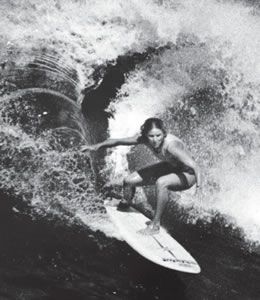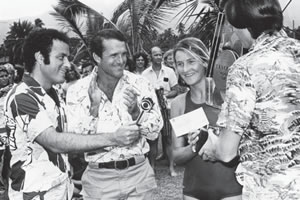When Margo Ruled World Waves

Oberg shreds in December 1979. Honolulu Star-Advertiser photo by Ken Sakamoto
There are some things in sports that seem to go hand-in-hand, like a hot dog at a baseball game.
The same is true for international competition, as certain nations are almost synonymous with a specific sport. When the United States men’s basketball team won the gold medal at the 2008 Beijing Olympics, it seemed order was restored after a rough stretch for the powerhouse.
A similar tale is being told right now in women’s surfing. On July 15, Oahu’s Carissa Moore reclaimed the world title for Hawaii after a 30-year drought. With her runner-up finish at France’s Roxy Pro Biarritz, Moore became the youngest ever winner of the Association of Surfing Professionals women’s championship. She has reached the finals in all six of her world tour events this season, notching three victories. The 2011 crown is locked up with the season’s final event still on tap, the Nike U.S. Open of Surfing, which runs Aug. 1-6 in Huntington Beach, Calif.
The dry spell for Hawaii dates back to 1981, when Kaua’i’s Margo Oberg took down the last of her three world titles under the International Professional Surfers governing body, which has since given way to the ASP.
“Lucky we live Hawaii,” Oberg says with a laugh. “A lot of times when people have asked me how I got to be a good surfer, I just say to them ‘I live on Kaua’i.'”
The preparation and experience the island waves provide are so unique, she says, and those fortunate enough to grow up in this environment benefit from its endless swells.

Al Michaels and Fred Hemmings with Margo Oberg in January 1976. Honolulu Star-Advertiser photo by Terry Luke
Oberg dominated her peers as a gromette in California before moving to Kaua’i in 1972. She continued to shine on the bigger stage, becoming the fiercest female pro charger in the world and winning the “official” world title in 1977, 1980 and 1981. She was eventually inducted into the Surfing Hall of Fame in 1991 and later had her name inscribed at the Huntington Beach Walk of Fame in 1995.
The island lifestyle turned her into the most influential female surfer of her era. The same environment is sending Moore who is still only 18 on a similar path. Regarding the new champion, Oberg says it’s more than just her birthplace.
“She’s so good anyway,” she says of Moore, who holds a National Scholastic Surfing Association record with 11 national titles in her four-year span from 2004 to 2007.
Oberg has been keeping an eye on Moore and the current state of women’s surfing, though with so much going on in her own life, she says her following is more of the general variety.
“This group of Australians and definitely some of the Hawaiians, they are a spunky bunch,” she says.
The current state of contest surfing is different than it was in Oberg’s dominant stretch, as she noted that big-wave riding has taken a back seat to creativity and aerial maneuvers on the smaller sets.
“Back then we were going at those big waves at Sunset (Beach),” she says, referring to the Oahu break where she made a name for herself. “But I think that riding small waves might even be more difficult.”
Now out of the limelight for some time, her presence in the water is still felt, as she owns and operates the Margo Oberg Surf School down at Poipu Beach, which has been in existence since 1977. The school operates every day and Oberg is out there to talk to the new riders along with her staff of instructors.
I might need to head down to see if I can learn a thing or two from the experienced pro. My surf technique has been referred to as “goofy,” which had nothing to do with my stance.



